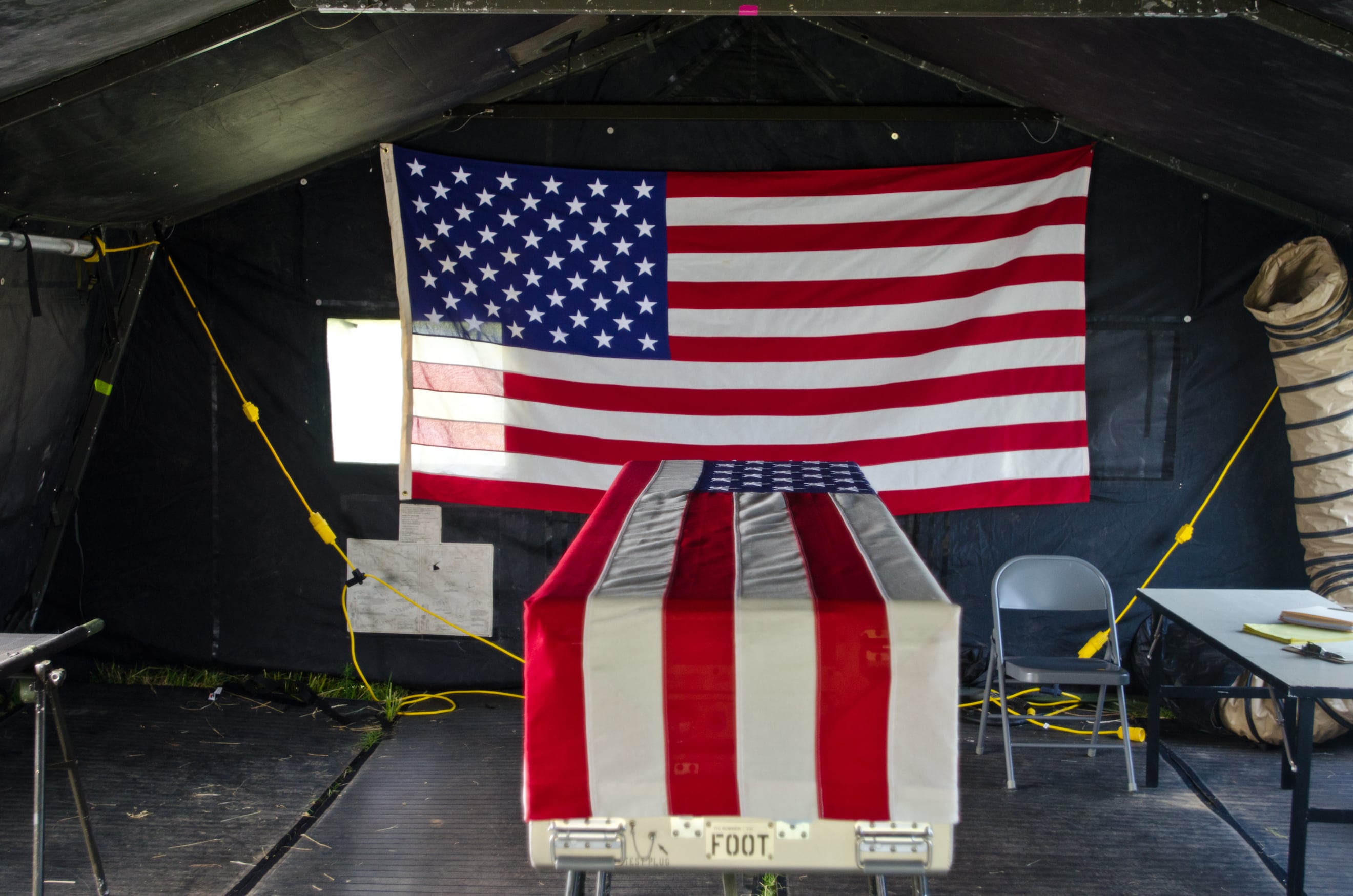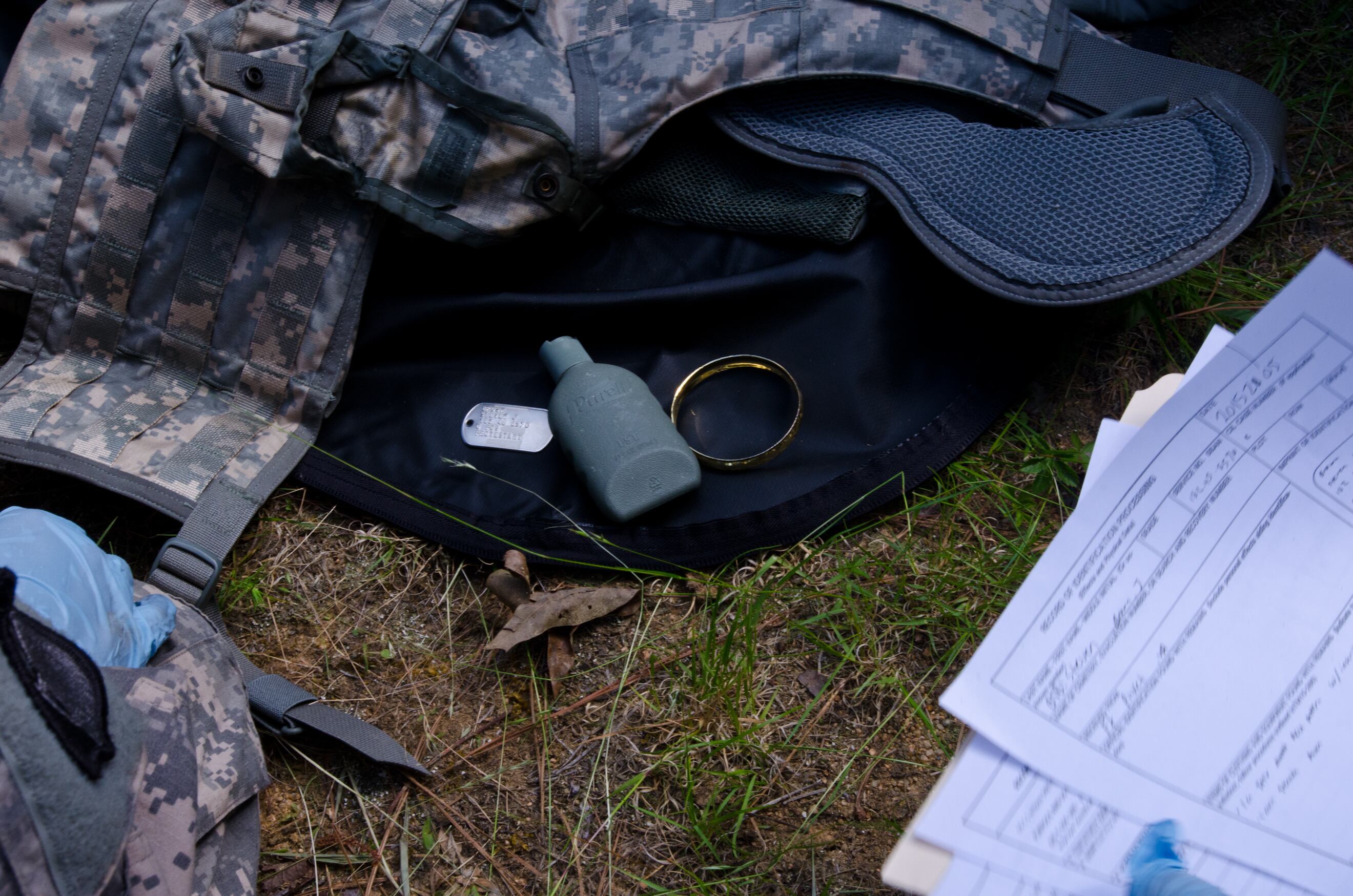This story won the 2023 Society for Professional Journalists Dateline Award for feature story in a newsletter or trade publication.
On a muggy Virginia morning, a petite soldier with dark brown hair adjusts her cover tightly on her head. Fifty yards away, in a bed of thick, unkempt grass around a burned out helicopter, a mannequin drenched in blood lies in wait.
The young soldier takes 10 steps before a man in a blue polo shirt yells, “Stop!”
“What did you do wrong?” he asks.
“I didn’t check for landmines,” the private replies, hands on her face.
“Right, now, how do we ensure that we don’t get blown up when we go to retrieve bodies?”
Another private shouts, “Sir, you low crawl over and tie a rope to the remains and flip them over from far away.”
“Exactly,” says the man in the blue shirt.
His name is Sgt. David Hansen, and he served with the Army for 12 years. Now he’s a government instructor with the Joint Mortuary Affairs Center at Fort Lee, teaching young soldiers how to step into the role of Mortuary Affairs Specialist, the men and women who handle the remains and personal effects of troops who die.
This year marks the first Memorial Day in the last two decades that the U.S. military has not been at war. And while combat casualties have slowed, those who deal with the remains of the fallen have not managed to avoid facing the dead each day.
At 45, Hansen has spent the last twenty years handling the dead while trying not to dwell on death.
“You just learn to make the best of it,” he said.
With a job like this, it’s not unusual for people to be curious about the worst things this group has seen.
Hansen’s most harrowing assignment was retrieving bodies from the Pentagon after Sept. 11, 2001.
“I had an advantage over some of my buddies that I was in with, because I was a medic before I joined the Army,” he added. “I’d already been through some chaos. The Pentagon was the first thing most of them did. We had to deal with a lot of remains all at once, and none of them in great shape.”
What helps, he said, is that mortuary affairs specialists handle remains and personal effects of the deceased but are kept separate from their families. Remains without a personal story are simply matters of mechanics. It creates a kind of cognitive dissonance.
Command Sgt. Major Daniel Davenport fights for these specialists to be kept away from funeral detail. That distance is what makes it possible to do the job. They don’t notify next of kin, meet the families at Dover Air Force Base in Delaware for dignified transfers, serve as pallbearers, or handle flags.
Specialists recover troops’ unprepared bodies, weapons, and personal effects off the battlefield. Sometimes they assist with the autopsy. They can choose to assist with the embalming. Other times, they’ll brief the escorts or serve as the escorts on the flight home.
It’s necessary, Davenport said, that these soldiers don’t view the remains as people killed in gruesome fashion. If they did, the toll would be insurmountable.

“We always tell them, ‘don’t invest, don’t try to learn too much about them, things like that,’” he said. “We try to have one team do personal effects while the other does the actual remains. And we try not let them work together, because you will find out a lot about someone through their personal effects.”
That combination creates an opportunity to humanize those lost and build an emotional connection.
“The only time I met the family of a set of remains that I took care of was after the Pentagon, my wife and I went up there for the 10th anniversary,” Hansen added.
While there, a woman approached him at a memorial spot marked for a woman whose body he had recovered after the attacks. She asked if Hansen had known her sister.
When he told her that he’d been the one to pull her body from the rubble, she was grateful. Her only question: “Do you think she suffered?”
“I didn’t tell them where we recovered her from or how we found her,” he said.
He recalled how the soldiers found her underneath the edge of the roof. They lifted the edge, and Hansen had to pull her out, making the decision to cut off one arm because a piece of rebar pinned her down.
She didn’t suffer, he told the sister.
“There’s always one that sticks with you,” Davenport said. “Everyone has one — maybe it’s their first, or someone that reminds them of someone they know, something that hits too close to home. It just stays with you, and you never forget it.”
Since the drawdown from Afghanistan, the soldiers have been dealing with a high rate of troop suicide.
According to Hansen, it’s much worse around the holidays. Soldiers away from home, particularly on their first deployments, struggle a lot with depression. He called the months of November through January “busy season.”
Davenport recalled a time when a mortuary affairs specialist himself was deeply affected by the work. He walked into the morgue and hung himself while stationed in Japan. His remains had to be sent elsewhere so his own unit didn’t have to process them.
“I will say, the kids and suicides are the hardest for us,” Davenport noted. “I stand by this comment to this day, the body does not lie. Every single [suicide] that I’ve ever seen, you can see the regret on their face.”
The military occupational specialty of Mortuary Affairs Specialist — 92M — is widely misunderstood. Their creed, according to the Army, is “dignity, reverence and respect.”
Since 1862, during the Civil War, mortuary affairs specialists have handled soldiers’ remains.
“They were among the first to land at Normandy, immediately opening cemeteries to care for the fallen,” according to Quartermaster history. “Among chaos, they established order and laid their brothers down. Whenever their country has called, they have been there.”
Many confuse the role’s tasks with the responsibilities of funeral detail or casualty assistance officer, those that knock on the doors of the deceased or hand their loved ones a flag at a memorial service.
“As a Mortuary Affairs Specialist, you’ll draw upon specialized medical training and the upmost respect and compassion to handle the remains and personal effects of soldiers who have fallen in the line of duty,” the Army MOS page says. “This includes locating and identifying remains in the field, ensuring safe transport of the deceased and their belongings, and assisting with arrangements and military honors at their burial site.”
This job description is ambiguous, perhaps on purpose, according to Sgt. 1st Class Marc Weyrich, a senior instructor at Fort Lee, because if recruits knew what it entailed, many soldiers wouldn’t want to do it.
“It’s kind of an unspoken MOS,” he said. “No one really understands what we do. Recruiters don’t know what they’re doing, mostly say things like ‘yeah, they just deal with dead people.’”

Soldiers that choose this career path carry out all the duties related to deceased personnel. This includes performing search and rescue missions for fallen service members both during and after combat, helping to disinter long lost remains, and prepare and preserve remains before they are laid to rest.
Mortuary affairs, as a division of the Army’s Quartermaster Corps, doesn’t just deal with remains of troops who die in combat. It also includes handling any American that dies on post, allies, contractors, third-party nationals, and occasionally even enemies.
Even outside periods of conflict, there isn’t much downtime for these specialists. In peacetime, they perform humanitarian assistance. For example, the 54th Quartermaster Company had a presence during the earthquake in Haiti, Hurricane Katrina, COVID-19 in New York, and the September 11, 2001 attacks.
Those that become 92Ms hope for the best but are prepared for the worst in war.
Mortuary affairs specialists maneuver through morbidity in a way that other soldiers do not, and often cannot. Because of the toll it can take on mental health, it is the only MOS where soldiers can attend training and reclassify without penalty.
“It’s a good job, but it’s a shitty job at the same time, because what we deal with,” Weyrich added. “I’m not here to do this for their comrades or their buddies. The whole goal is to get them home, back to their families.”
Davenport wants other soldiers to know that mortuary affairs specialists aren’t strange or morbid.
Because they work with death, they face a level of stigma from other service members. Sometimes they are viewed as a bad luck omen by superstitious units with which they might serve. Davenport admitted that sometimes he tells people he works in logistics, because it’s simpler.
“It takes a very empathetic individual to do this job,” he said, “They never truly receive closure, but they understand they do it for the family. Even if they never meet that family, they do it for family.”
Pvt. Raquel Rojas joined the Army just two months ago with the sole intention of serving as a mortuary affairs specialist.
Up to 40 percent of the soldiers that end up serving in this MOS are reclassified from an MOS they actually wanted. Others pick this job because they want a shortened Advanced Individual Training period. In some instances, however, soldiers view this as an opportunity to serve in a role that has profound meaning.
“It’s a combination of art and science,” Rojas said. “Someone’s remains could be disfigured, and, with just a picture and the tools you learn here, you can bring a person back.”
The act of final dress, she noted, gives the family closure, “a final image of their loved one before they send them off.”
The trainees, typically sequestered in classes of seven or eight, learn how to assess a battlefield for casualties, document remains and personal effects, and carry out basic morgue functions — culminating in a trip to the Richmond Medical Examiner’s office, where they will see a body up close.
“It’s the closest they can get to a combat fatality,” Weyrich said.
And it’s the part of their seven-week training that these soldiers say they most look forward to, as morbid as it may be.
“This is my second time going,” Rojas said. “The first time I was nervous, but once I kind of got my hands dirty, I was fine.”
Much of the fear for these students lies not in the handling of remains themselves, but who they are holding. For Rojas, it’s the chance of ever finding someone she knows on her table. Others say it’s the very real possibility of handling the bodies of recovered children.
For the most part, the recruits all say the same thing when asked why they are here, at Fort Lee, tagging mannequins, documenting personal effects, and visiting morgues: It’s about the families.
“When we do our job, we do not do it for the United States Army,” Davenport said. “We are working for the family of the soldier in front of us.”
Sarah Sicard is a Senior Editor with Military Times. She previously served as the Digitial Editor of Military Times and the Army Times Editor. Other work can be found at National Defense Magazine, Task & Purpose, and Defense News.




